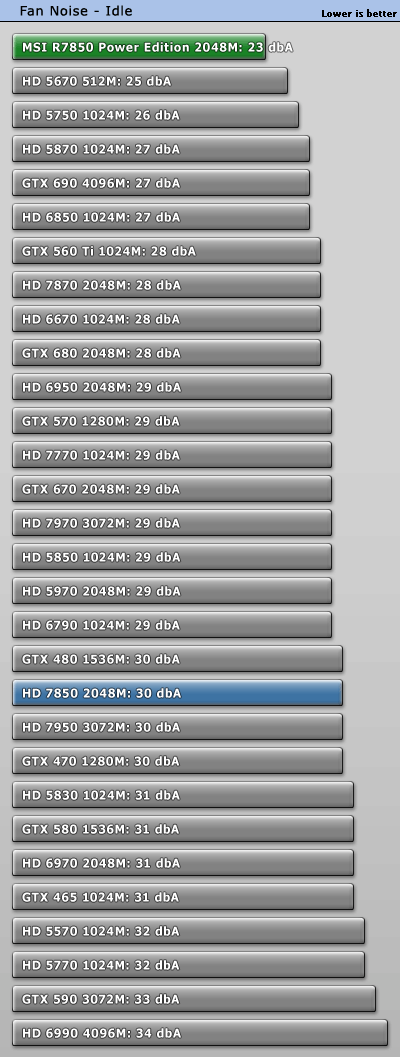 12
12
MSI R7850 Power Edition 2 GB Review
Performance Summary »Fan Noise
In the past years users would accept everything just to get more performance. Nowadays this has changed and people have become more aware of the fan noise and power consumption of their graphic cards.In order to properly test the fan noise a card emits we are using a Bruel & Kjaer 2236 sound level meter (~$4,000) which has the measurement range and accuracy we are looking for.

The tested graphics card is installed in a system that is completely passively cooled. That is passive PSU, passive CPU cooler, passive cooling on the motherboard and a solid state drive.
This setup allows us to eliminate secondary noise sources and test only the video card. To be more compliant with standards like DIN 45635 (we are not claiming to be fully DIN 45635 certified) the measurement is conducted at 100 cm distance and 160 cm over the floor. The ambient background noise level in the room is well below 20 dBA for all measurements. Please note that the dBA scale is not linear, it is logarithmic. 40 dBA is not twice as loud as 20 dBA. A 3 dBA increase results in double the sound pressure. The human hearing is a bit different and it is generally accepted that a 10 dBA increase doubles the perceived sound level. The 3D load noise levels are tested with a stressful game, not Furmark.
Idle fan noise of the R7850 Power Edition is outstanding. With 23 dbA it sits on the idle noise throne, no other card ever got lower, but others reached the same levels.
Under load the fan ramps up a lot to provide super low temperatures but the result is way too much fan noise. Ok, it is a tiny bit quieter than the AMD reference design, but that's a noisy board, too. Other AIBs do a much better job here, providing a more balanced approach to temperature and noise.


Apr 23rd, 2024 20:15 EDT
change timezone
Latest GPU Drivers
New Forum Posts
- What's your latest tech purchase? (20317)
- The TPU UK Clubhouse (24766)
- need help with motherboard/ ram compability certainty (14)
- Sexy Mechanical Keyboard Thread (482)
- My computer setup - Request for opinions (12)
- Show us your collections thread!! (282)
- Realtek Modded Audio Driver for Windows 10/11 - Only for HDAUDIO (5687)
- What phone you use as your daily driver? And, a discussion of them. (1454)
- Is there a technical reason that Windows 11 doesn't have built into it battery charge limitation? (37)
- ThrottleStop 9.6 Voltage won't change (1)
Popular Reviews
- Fractal Design Terra Review
- Corsair 2000D Airflow Review
- Thermalright Phantom Spirit 120 EVO Review
- Minisforum EliteMini UM780 XTX (AMD Ryzen 7 7840HS) Review
- ASUS GeForce RTX 4090 STRIX OC Review
- NVIDIA GeForce RTX 4090 Founders Edition Review - Impressive Performance
- ASUS GeForce RTX 4090 Matrix Platinum Review - The RTX 4090 Ti
- MSI GeForce RTX 4090 Gaming X Trio Review
- MSI GeForce RTX 4090 Suprim X Review
- Gigabyte GeForce RTX 4090 Gaming OC Review
Controversial News Posts
- Sony PlayStation 5 Pro Specifications Confirmed, Console Arrives Before Holidays (116)
- NVIDIA Points Intel Raptor Lake CPU Users to Get Help from Intel Amid System Instability Issues (106)
- AMD "Strix Halo" Zen 5 Mobile Processor Pictured: Chiplet-based, Uses 256-bit LPDDR5X (101)
- US Government Wants Nuclear Plants to Offload AI Data Center Expansion (98)
- Windows 10 Security Updates to Cost $61 After 2025, $427 by 2028 (84)
- Developers of Outpost Infinity Siege Recommend Underclocking i9-13900K and i9-14900K for Stability on Machines with RTX 4090 (84)
- TechPowerUp Hiring: Reviewers Wanted for Motherboards, Laptops, Gaming Handhelds and Prebuilt Desktops (74)
- Intel Realizes the Only Way to Save x86 is to Democratize it, Reopens x86 IP Licensing (70)
